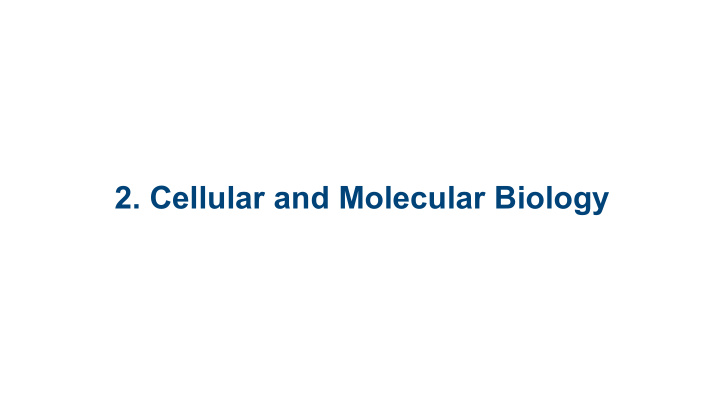



2. Cellular and Molecular Biology
2.1 Cell Structure 2.2 Transport Across Cell Membranes 2.3 Cellular Metabolism
2.4 DNA Replication 2.5 Cell Division 2.6 Biosynthesis
2.1 Cell Structure
What is a cell? The smallest and most basic unit of most organisms. Species can be single celled (like Salmonella bacteria) or multicellular and complex, like humans.
There are two main types of cells. Prokaryotes (like bacteria) have no nucleus or other membrane-bound organelles DNA is a single circular chromosome Unicellular organisms
Eukaryotes (like plants, fungi, and animal cells) have a nucleus as well as other membrane- bound organelles DNA is arranged into multiple chromosomes Unicellular and multicellular organisms
Plant and Animal cells both contain • a cell membrane • a nucleus • cytoplasm • cytoplasmic organelles
Animal and Plant cells also contain • microvilli • a cytoskeleton • ribosomes • endoplasmic reticulum • Golgi apparatus • lysosomes • mitochondria
Mitochondria – produce energy (cellular respiration) Ribosomes – site of protein synthesis
Plant cells additionally contain • a cell wall • chloroplasts • a central vacuole
The cell membrane separates the cell from its environment, allowing for the interior environment of the cell to be very different from the exterior
The cell membrane is composed of • a lipid bilayer • proteins • carbohydrates
2.2 Transport Across Cell Membranes
Cell membranes protect the interior of the cell from the exterior. Transport of molecules across the membrane is possible, and depends upon the size and polarity of the molecule.
Transport across cell membranes has two basic types • Passive transport • Simple diffusion • Osmosis • Facilitated diffusion • Active transport
Simple diffusion, with a concentration gradient, small nonpolar molecules Polar Non-polar
Facilitated diffusion, small polar molecules, like glucose, amino acids
In active transport molecules move across cell membranes with an expenditure of energy • Moving against a concentration gradient • Requires energy, usually in the form of ATP
2.3 Cellular Metabolism
Cellular Metabolism encompasses all types of energy transformation in cells • Photosynthesis • Respiration • Growth • Movement
Metabolic Pathways
Adenosine triphosphate, or ATP, is the primary energy currency in biological systems • Energy is released by hydrolysis of one of the phosphate groups to form ADP • Energy is stored by attaching a new phosphate group to ADP to form ATP
Photosynthesis takes place in cells with chlorophyll, a green pigment that can absorb light • Typically in plants • Two phases • Light reaction • Dark reaction
Respiration takes place in all cells • Glucose is broken down to release energy (glycolysis) • Two types Anaerobic (no O 2 ) • Aerobic (with O 2 ) •
Net outcome of glycolysis (from 1 molecule of glucose) • 2 molecules of pyruvate • 4 ATP • 2 NADH
2.4 DNA Replication
What is DNA? DeoxyriboNucleic Acid A biopolymer that encodes all of the information needed to form a specific organism and produce proteins for functioning A gene is a portion of DNA that encodes a specific protein
2’-DeoxyriboNucleic Acid
Since DNA codes for genes, which contain the blueprint for an organism, its important to be able to make copies of this blueprint for each cell The end result of DNA replication is two pieces of double stranded DNA identical to the parent DNA
In transcription, an RNA (ribonucleic acid) copy of the DNA is made. What does it mean to transcribe something?
In translation, the information contained in the RNA copy of the DNA is used to guide the creation of proteins. What does it mean to translate something?
replication DNA transcription RNA translation Protein
2.5 Cell Division
Cell division is the process of cellular reproduction, where a copy of the cells “blueprint” needs to be made and passed on
homologs chromatids centromere
Mitosis A sequence of events that ends with cell division and the creation of two daughter cells from a single parent cell
4 Phases of Mitosis • Prophase • Metaphase • Anaphase • Telophase
Meiosis is a type of cell division that takes place in eukaryotes. It reduces the chromosome number by half, resulting in 4 daughter cells (gametes) that are all genetically distinct from the parent cell as part of reproduction.
2.6 Biosynthesis
Biosynthesis is the process of making chemical compounds, like proteins and DNA, by living things. Through anabolic processes, small molecules and building blocks can get built up into larger functional systems.
Enzymes are made primarily of protein and act as catalysts to help reactions take place in biological systems by lowering the activation energy, and therefore increasing the rate of reaction .
Recommend
More recommend